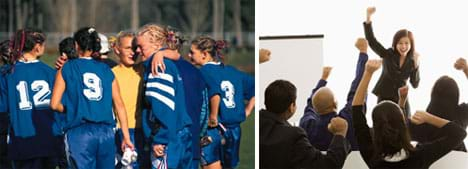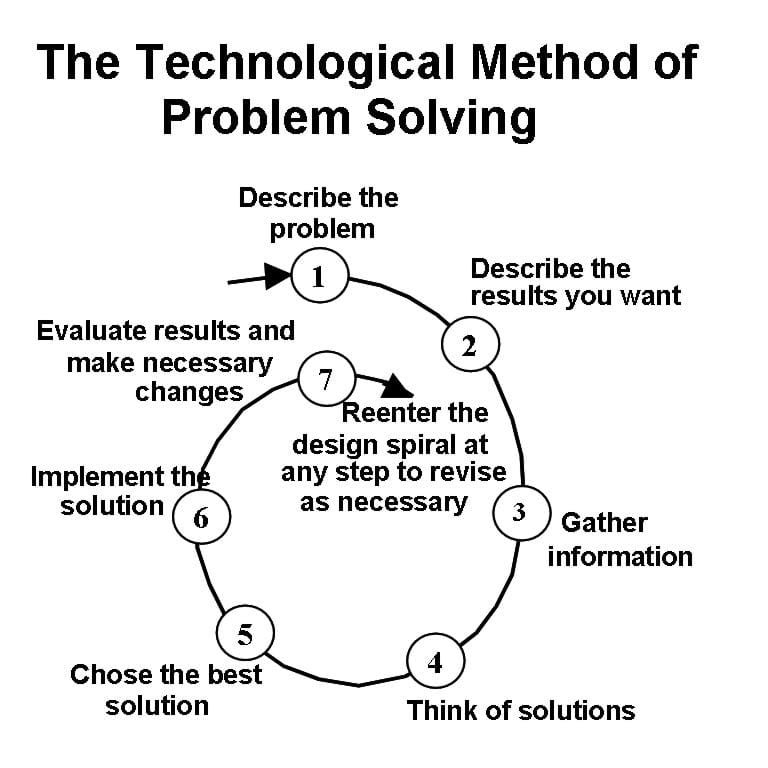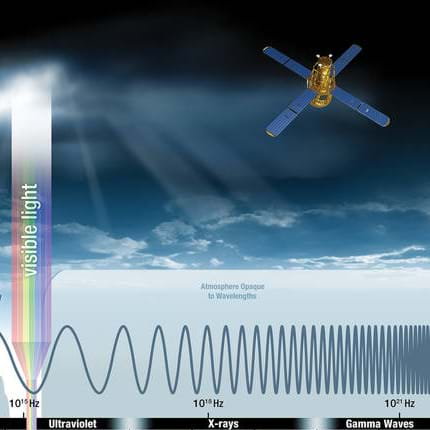Quick Look
Grade Level: 8 (6-8)
Time Required: 1 hours 15 minutes
(two 40-minute class periods)
Lesson Dependency:
Subject Areas: Physical Science, Science and Technology

Summary
Students are introduced to a systematic procedure for solving problems through a demonstration and then the application of the method to an everyday activity. The unit project is introduced to provide relevance to subsequent lessons.Engineering Connection
Scientists, engineers and ordinary people use problem solving each day to work out solutions to various problems. Using a systematic and iterative procedure to solve a problem is efficient and provides a logical flow of knowledge and progress.
Learning Objectives
- Students demonstrate an understanding of the Technological Method of Problem Solving.
- Students are able to apply the Technological Method of Problem Solving to a real-life problem.
Educational Standards
Each TeachEngineering lesson or activity is correlated to one or more K-12 science,
technology, engineering or math (STEM) educational standards.
All 100,000+ K-12 STEM standards covered in TeachEngineering are collected, maintained and packaged by the Achievement Standards Network (ASN),
a project of D2L (www.achievementstandards.org).
In the ASN, standards are hierarchically structured: first by source; e.g., by state; within source by type; e.g., science or mathematics;
within type by subtype, then by grade, etc.
Each TeachEngineering lesson or activity is correlated to one or more K-12 science, technology, engineering or math (STEM) educational standards.
All 100,000+ K-12 STEM standards covered in TeachEngineering are collected, maintained and packaged by the Achievement Standards Network (ASN), a project of D2L (www.achievementstandards.org).
In the ASN, standards are hierarchically structured: first by source; e.g., by state; within source by type; e.g., science or mathematics; within type by subtype, then by grade, etc.
NGSS: Next Generation Science Standards - Science
-
The iterative process of testing the most promising solutions and modifying what is proposed on the basis of the test results leads to greater refinement and ultimately to an optimal solution.
(Grades 6 - 8)
More Details
Do you agree with this alignment?
-
A solution needs to be tested, and then modified on the basis of the test results in order to improve it. There are systematic processes for evaluating solutions with respect to how well they meet criteria and constraints of a problem.
(Grades 6 - 8)
More Details
Do you agree with this alignment?
International Technology and Engineering Educators Association - Technology
-
Students will develop an understanding of the attributes of design.
(Grades
K -
12)
More Details
Do you agree with this alignment?
-
Students will develop an understanding of engineering design.
(Grades
K -
12)
More Details
Do you agree with this alignment?
-
Illustrate the benefits and opportunities associated with different approaches to design.
(Grades
6 -
8)
More Details
Do you agree with this alignment?
State Standards
National Science Education Standards - Science
-
Perfectly designed solutions do not exist. All technological solutions have trade-offs, such as safety, cost, efficiency, and appearance. Engineers often build in back-up systems to provide safety. Risk is part of living in a highly technological world. Reducing risk often results in new technology.
(Grades
5 -
8)
More Details
Do you agree with this alignment?
-
Technological solutions have intended benefits and unintended consequences. Some consequences can be predicted, others cannot.
(Grades
5 -
8)
More Details
Do you agree with this alignment?
Worksheets and Attachments
Visit [www.teachengineering.org/lessons/view/cla_lesson2_problem_solving] to print or download.Introduction/Motivation
Scientists, engineers, and ordinary people use problem solving each day to work out solutions to various problems. Using a systematic and iterative procedure to solve a problem is efficient and provides a logical flow of knowledge and progress.
In this unit, we use what is called "The Technological Method of Problem Solving." This is a seven-step procedure that is highly iterative—you may go back and forth among the listed steps, and may not always follow them in order. Remember that in most engineering projects, more than one good answer exists. The goal is to get to the best solution for a given problem. Following the lesson conduct the associated activities Egg Drop and Solving Energy Problems for students to employ problem solving methods and techniques.
Lesson Background and Concepts for Teachers
The overall concept that is important in this lesson is: Using a standard method or procedure to solve problems makes the process easier and more effective.

The specific process of problem solving used in this unit was adapted from an eighth-grade technology textbook written for New York State standard technology curriculum. The process is shown in Figure 1, with details included below. The spiral shape shows that this is an iterative, not linear, process. The process can skip ahead (for example, build a model early in the process to test a proof of concept) and go backwards (learn more about the problem or potential solutions if early ideas do not work well).
This process provides a reference that can be reiterated throughout the unit as students learn new material or ideas that are relevant to the completion of their unit projects.
Brainstorming about what we know about a problem or project and what we need to find out to move forward in a project is often a good starting point when faced with a new problem. This type of questioning provides a basis and relevance that is useful in other energy science and technology units. In this unit, the general problem that is addressed is the fact that Americans use a lot of energy, with the consequences that we have a dwindling supply of fossil fuels, and we are emitting a lot of carbon dioxide and other air pollutants. The specific project that students are assigned to address is an aspect of this problem that requires them to identify an action they can take in their own live to reduce their overall energy (or fossil fuel) consumption.
The Seven Steps of Problem Solving
1. Identify the problem
Clearly state the problem. (Short, sweet and to the point. This is the "big picture" problem, not the specific project you have been assigned.)
2. Establish what you want to achieve
- Completion of a specific project that will help to solve the overall problem.
- In one sentence answer the following question: How will I know I've completed this project?
- List criteria and constraints: Criteria are things you want the solution to have. Constraints are limitations, sometimes called specifications, or restrictions that should be part of the solution. They could be the type of materials, the size or weight the solution must meet, the specific tools or machines you have available, time you have to complete the task and cost of construction or materials.
3. Gather information and research
- Research is sometimes needed both to better understand the problem itself as well as possible solutions.
- Don't reinvent the wheel – looking at other solutions can lead to better solutions.
- Use past experiences.
4. Brainstorm possible solutions
List and/or sketch (as appropriate) as many solutions as you can think of.
5. Choose the best solution
Evaluate solution by: 1) Comparing possible solution against constraints and criteria 2) Making trade-offs to identify "best."
6. Implement the solution
- Develop plans that include (as required): drawings with measurements, details of construction, construction procedure.
- Define tasks and resources necessary for implementation.
- Implement actual plan as appropriate for your particular project.
7. Test and evaluate the solution
- Compare the solution against the criteria and constraints.
- Define how you might modify the solution for different or better results.
Associated Activities
- Egg Drop - Use this demonstration or activity to introduce and use the problem solving method. Encourages creative design.
- Solving Energy Problems - Unit project is assigned and students begin with problem solving techniques to begin to address project. Mostly they learn that they do not know enough yet to solve the problem.
- Energy Projects - Students use what they learned about energy systems to create a project related to identifying and carrying out a personal change to reduce energy consumption.
Assessment
The results of the problem solving activity provide a basis for the entire semester project. Collect and review the worksheets to make sure that students are started on the right track.
Subscribe
Get the inside scoop on all things TeachEngineering such as new site features, curriculum updates, video releases, and more by signing up for our newsletter!More Curriculum Like This

Learn the basics of the analysis of forces engineers perform at the truss joints to calculate the strength of a truss bridge known as the “method of joints.” Find the tensions and compressions to solve systems of linear equations where the size depends on the number of elements and nodes in the trus...

Through role playing and problem solving, this lesson sets the stage for a friendly competition between groups to design and build a shielding device to protect humans traveling in space. The instructor asks students—how might we design radiation shielding for space travel?

A process for technical problem solving is introduced and applied to a fun demonstration. Given the success with the demo, the iterative nature of the process can be illustrated.

The culminating energy project is introduced and the technical problem solving process is applied to get students started on the project. By the end of the class, students should have a good perspective on what they have already learned and what they still need to learn to complete the project.
References
Hacker, M, Barden B., Living with Technology, 2nd edition. Albany NY: Delmar Publishers, 1993.
Other Related Information
This lesson was originally published by the Clarkson University K-12 Project Based Learning Partnership Program and may be accessed at http://internal.clarkson.edu/highschool/k12/project/energysystems.html.
Copyright
© 2013 by Regents of the University of Colorado; original © 2008 Clarkson UniversityContributors
Susan Powers; Jan DeWaters; and a number of Clarkson and St. Lawrence students in the K-12 Project Based Learning Partnership ProgramSupporting Program
Office of Educational Partnerships, Clarkson University, Potsdam, NYAcknowledgements
This lesson was developed under National Science Foundation grants no. DUE 0428127 and DGE 0338216. However, these contents do not necessarily represent the policies of the National Science Foundation, and you should not assume endorsement by the federal government.
Last modified: August 16, 2023










User Comments & Tips